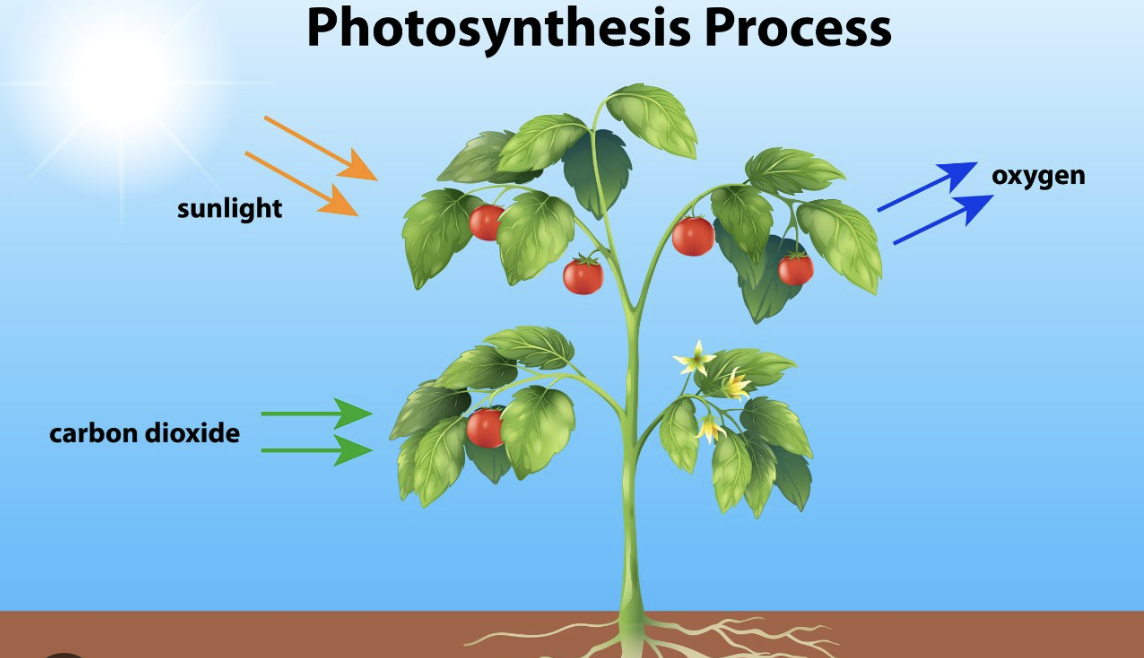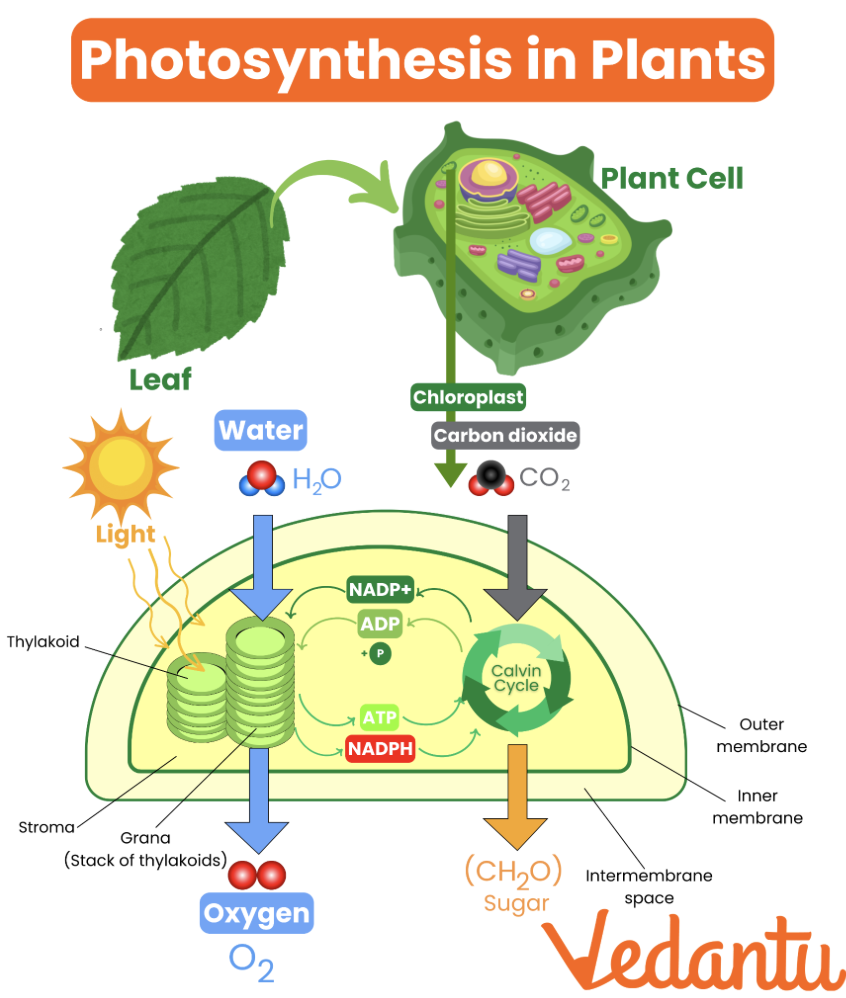Photosynthesis is a crucial biochemical process where green plants, algae, and some bacteria transform light energy into chemical energy as glucose, utilising carbon dioxide and water. The overall chemical equation can be represented as 6CO_2 + 6H_2O + light energy -> C_6H_12O_6 + 6O_2. This process occurs in two main stages: the light-dependent reactions take place in the thylakoid membranes of chloroplasts, generating ATP and NADPH while releasing oxygen. Meanwhile, the Calvin Cycle happens in the stroma and uses those products to turn carbon dioxide into glucose. This not only supports life by producing oxygen but also maintains the carbon cycle. Factors like light intensity and temperature can affect its efficiency significantly.

Photosynthesis is the process that allows green plants, algae, and some bacteria to turn light energy into chemical energy. This transformation is crucial for the survival of life on Earth. During photosynthesis, these organisms use sunlight, water, and carbon dioxide to create glucose, a type of sugar that serves as food, while also releasing oxygen as a by-product. This process can be summarised by the chemical equation: 6CO₂ + 6H₂O + light energy → C₆H₁₂O₆ + 6O₂. Essentially, photosynthesis provides the oxygen we breathe and forms the foundation of the food chain, making it vital for both plants and animals. Without photosynthesis, life as we know it would not be sustainable.

Photosynthesis is summarised by a fundamental chemical equation:
6CO_2 + 6H_2O + light energy -> C_6H_12O_6 + 6O_2
In this equation, six molecules of carbon dioxide react with six molecules of water, utilising light energy to produce one molecule of glucose and six molecules of oxygen. This process primarily occurs in the chloroplasts of green plants, where chlorophyll captures light energy.
To break it down, the carbon dioxide enters the plant through tiny openings called stomata, while water is absorbed through the roots. The light energy, usually from the sun, is essential as it drives the entire process. The glucose produced serves as an energy source for the plant and can also be converted into other carbohydrates for storage. The released oxygen is vital for the survival of most life forms on Earth, contributing to the air we breathe.
This equation not only highlights the conversion of light energy into chemical energy but also showcases the interconnectedness of life. The glucose produced fuels plant growth, while the oxygen generated supports respiration in animals and humans, illustrating a fundamental relationship within ecosystems.
|
Component |
Chemical Formula |
Role |
|---|---|---|
|
Carbon Dioxide |
6CO₂ |
Reactant used in photosynthesis |
|
Water |
6H₂O |
Reactant used in photosynthesis |
|
Glucose |
C₆H₁₂O₆ |
Product of photosynthesis |
|
Oxygen |
6O₂ |
Byproduct released during photosynthesis |
|
Light Energy |
N/A |
Energy source for the reaction |
Photosynthesis consists of two main stages: the light-dependent reactions and the Calvin cycle, also known as the light-independent reactions.
The light-dependent reactions take place in the thylakoid membranes of chloroplasts. During this stage, chlorophyll absorbs sunlight, which energises electrons. This energy is used to split water molecules through a process called photolysis, releasing oxygen as a by-product. Additionally, the energy captured is converted into chemical energy in the form of ATP and NADPH, which are crucial for the next stage of photosynthesis.
The Calvin cycle occurs in the stroma of chloroplasts. It does not require light directly, hence its name as light-independent reactions. Here, ATP and NADPH produced in the light-dependent stage are utilised to convert carbon dioxide from the atmosphere into glucose. The process involves three key phases: first, carbon fixation, where CO2 is attached to a five-carbon sugar, ribulose bisphosphate (RuBP); second, the reduction phase, where ATP and NADPH are used to convert the fixed carbon into glyceraldehyde-3-phosphate (G3P), a three-carbon sugar; and finally, the regeneration of RuBP, ensuring the cycle can continue.
Understanding these stages is vital, as they not only illustrate how plants produce food but also highlight the central role of photosynthesis in maintaining life on Earth.
The light-dependent reactions are the first stage of photosynthesis, taking place in the thylakoid membranes of chloroplasts. During this process, chlorophyll and other pigments absorb sunlight. This energy is then transformed into chemical energy in the form of ATP (adenosine triphosphate) and NADPH (nicotinamide adenine dinucleotide phosphate), which are essential for the next phase of photosynthesis.
A key feature of the light-dependent reactions is the splitting of water molecules, a process known as photolysis. When water is split, it releases oxygen as a by-product, which is crucial for life on Earth. This reaction also contributes to the electrons needed to drive the formation of ATP and NADPH.
For example, when sunlight strikes the chlorophyll, it energises electrons, which then move through a series of proteins in the thylakoid membrane, known as the electron transport chain. As these electrons move, they help pump hydrogen ions into the thylakoid space, creating a gradient that is used to generate ATP through a process called chemiosmosis.
Overall, the light-dependent reactions not only capture and convert solar energy but also lay the groundwork for the Calvin Cycle, where the ATP and NADPH produced are used to synthesise glucose from carbon dioxide.
The Calvin Cycle, also known as the light-independent reactions, takes place in the stroma of chloroplasts and is crucial for converting carbon dioxide into glucose using the ATP and NADPH generated during the light-dependent reactions. This cycle can be divided into three main phases.
In the first phase, known as carbon fixation, an enzyme called RuBisCO catalyses the reaction of carbon dioxide with ribulose bisphosphate (RuBP), producing a 6-carbon compound that quickly splits into two 3-phosphoglycerate (3-PGA) molecules.
The second phase is the reduction phase, where ATP and NADPH are used to convert 3-PGA into glyceraldehyde-3-phosphate (G3P), a three-carbon sugar. Some of the G3P molecules exit the cycle to contribute to glucose formation, while others continue in the cycle.
Finally, the regeneration phase occurs, where some G3P molecules are used to regenerate RuBP, allowing the cycle to continue. This regeneration requires additional ATP. Overall, the Calvin Cycle is vital for synthesising organic molecules, forming the foundation for the energy needs of nearly all living organisms.
The rate of photosynthesis is affected by several key factors, each playing a crucial role in the efficiency of this vital process. Light intensity is one of the most significant factors; as light levels increase, the rate of photosynthesis typically rises, up to a certain point. Beyond this point, other factors may become limiting. For example, on a bright sunny day, plants can photosynthesise rapidly, but if there is insufficient carbon dioxide or water available, the process can slow down.
Carbon dioxide concentration is another critical factor. Higher levels of carbon dioxide can enhance the rate of photosynthesis, as it is one of the essential reactants in the process. This is why greenhouses often supplement CO2 levels to maximise plant growth. However, like light, there is a saturation point, after which increasing CO2 does not significantly affect the rate of photosynthesis.
Temperature also plays a vital role, as enzymes involved in photosynthesis have optimal temperature ranges. Generally, warmer temperatures can speed up the reactions up to a point. If temperatures become too high, the enzymes may denature, causing the rate of photosynthesis to decline. For instance, many plants thrive in temperatures between 20°C and 30°C, while higher temperatures may lead to reduced photosynthetic activity.
Additionally, water availability is crucial; insufficient water can lead to stomatal closure, limiting carbon dioxide uptake and thus reducing photosynthesis. Environmental conditions such as humidity and soil nutrient levels can also indirectly influence the rate of photosynthesis by affecting plant health and water availability.
Light intensity
Carbon dioxide concentration
Temperature
Water availability
Chlorophyll concentration
Soil nutrients
Type of plant species
The Degree Gap stands out as a premier tutoring service that aims to bridge the gap in understanding complex biological concepts, particularly those surrounding photosynthesis. With a team of expert tutors who have achieved top grades in their GCSE and A-Level Biology, students are provided with the guidance they need to navigate challenging topics. For instance, when grappling with the intricate details of the Calvin Cycle or the role of light-dependent reactions, having a knowledgeable tutor can make a significant difference in comprehension. The Degree Gap offers flexible learning options, allowing students to learn at their own pace through a pay-as-you-go system. This approach ensures that every student can access tailored support that fits their schedule, making the learning process both effective and enjoyable. The commitment to excellence is evident in the personalised attention each student receives, empowering them to excel academically and fostering a deeper understanding of biology.
At The Degree Gap, we understand that every student learns differently. Our flexible learning options are designed to cater to individual needs and schedules. We offer a pay-as-you-go system that allows students to choose sessions based on their availability and pace of learning. This approach ensures that students can delve into complex topics like photosynthesis at a comfortable speed, receiving support when they need it most. Our expert tutors, who have excelled in their biology studies, can provide tailored assistance to help clarify concepts, making learning both effective and enjoyable. Whether a student requires a quick refresher on the stages of photosynthesis or in-depth help with the chemical equation, our adaptable tutoring model fosters an environment where academic success is attainable for all.
At The Degree Gap, we recognise the challenges students face when trying to grasp complex biological concepts, such as photosynthesis. Our commitment to academic excellence is reflected in the expertise of our tutors, who have not only achieved top grades in their GCSE and A-Level Biology but also possess a deep passion for teaching. We believe that fostering a thorough understanding of topics like photosynthesis is crucial, as it forms the foundation of many biological processes. By offering personalised tutoring sessions, we aim to bridge the gaps in knowledge and instil a sense of confidence in our students. Our flexible learning options allow students to engage with the material at their own pace, ensuring they develop a robust understanding of vital concepts, including the significance of photosynthesis in the ecosystem. This dedication to high-quality education empowers our students to excel academically and prepares them for future academic pursuits.
Photosynthesis is the process that plants use to make their food. They take in sunlight, carbon dioxide from the air, and water from the soil to create glucose, a type of sugar, and oxygen.
Sunlight provides the energy needed for photosynthesis. Plants use this energy to convert carbon dioxide and water into glucose.
Plants use glucose as their main source of energy for growth and development. They can also store it for later use.
Plants absorb carbon dioxide through small openings on their leaves called stomata. These openings allow gases to enter and leave the plant.
Water is essential for photosynthesis as it is one of the raw materials needed to produce glucose. It also helps transport nutrients within the plant.
TL;DR Photosynthesis is the process through which plants convert light energy into glucose, summarised by the equation 6CO₂ + 6H₂O + light energy → C₆H₁₂O₆ + 6O₂. It consists of two stages: light-dependent reactions that generate ATP and oxygen, and the Calvin Cycle which produces glucose using ATP and NADPH. The rate of photosynthesis is affected by light intensity, carbon dioxide concentration, and temperature. The Degree Gap offers expert biological tutoring to help students understand these concepts better, with flexible learning options and a commitment to academic excellence.